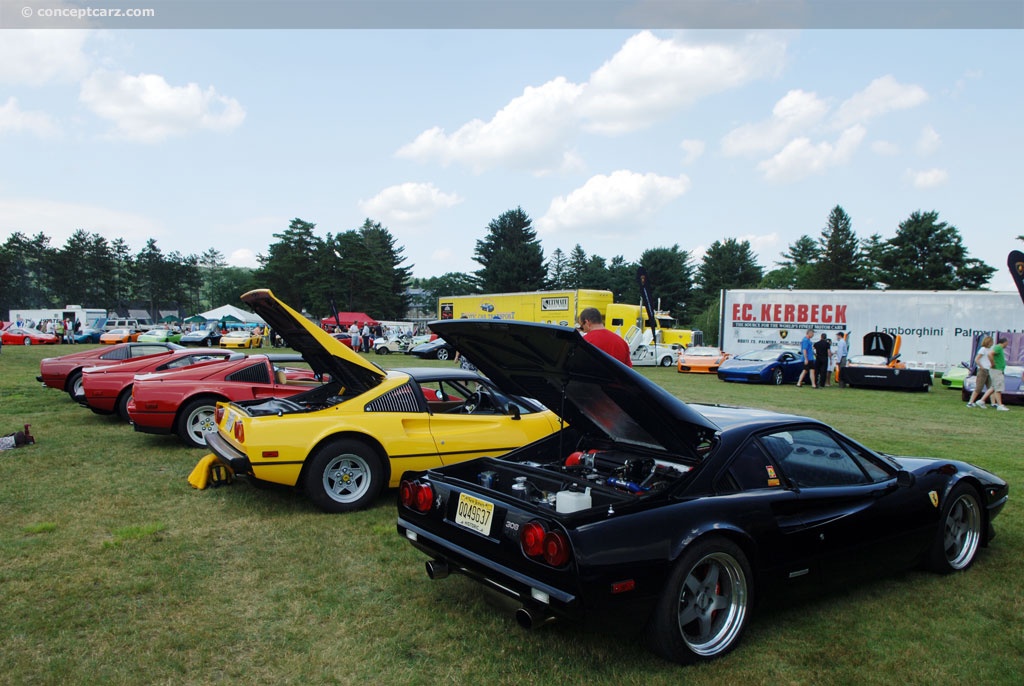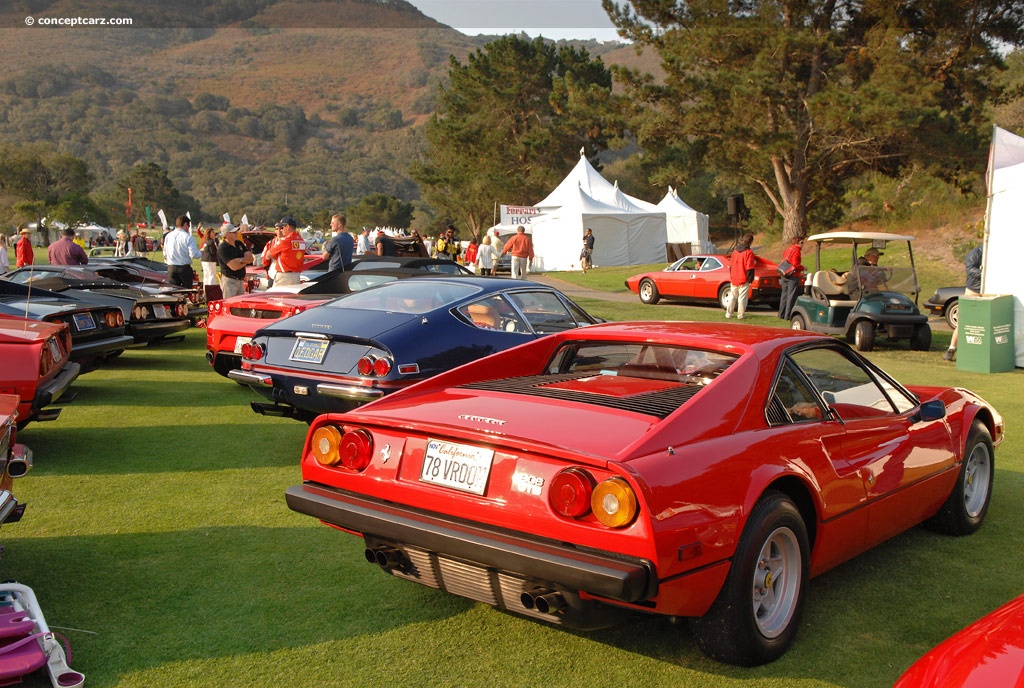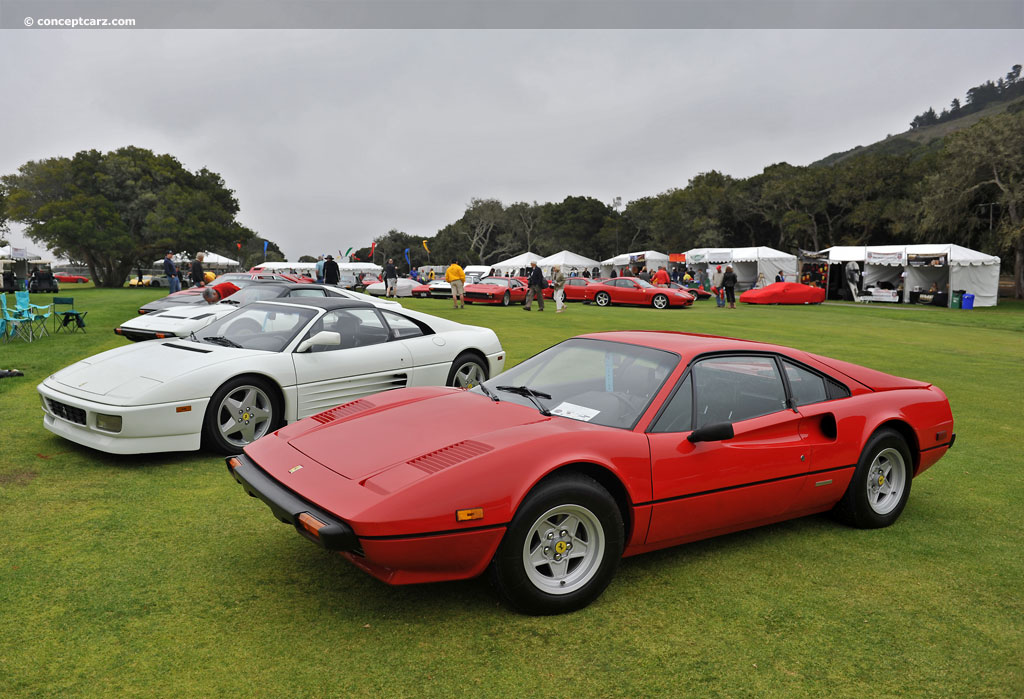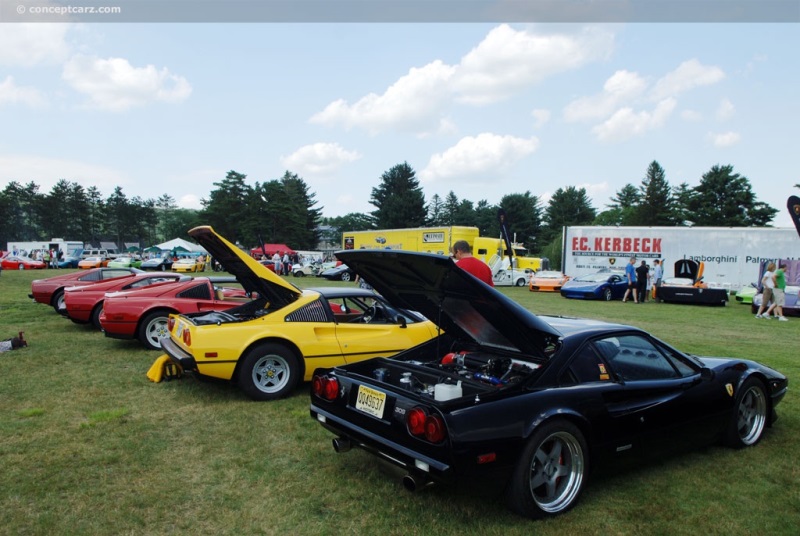The Ferrari 308 GTB was a combination of curvaceous bodywork and approachable performance, with its low curb weight and potent V8 allowing it to sprint from zero-to-sixty mph in 6.6 seconds and top speeds in excess of 150 mph. It was introduced in October of 1975 at the Paris Motorshow and superseded the Dino 246 GT as the company's mid-engined sportscar offering. 
Coupe by Scaglietti
Chassis #: 22857
View info and historyThe stunning two-seat coachwork was created by Leonardo Fioravanti of Pininfarina and incorporated some of its predecessor's design cues with the later 365 GT4/BB. Items adopted from the Boxer include the dihedral groove at bumper level splitting top and bottom, the plunging nose, and the sail panels reaching back to meet a shallower spoiler. From the Dino came the conical side air intakes and recessed concave rear window. The GTS models had a removable roof panel with a grained satin black finish, and when not in use, could be stowed in a vinyl cover behind the seats. The 308 rode on five-spoke 14-inch alloy wheels, and later in production, a 16-inch wheel became optional along with high compression pistons, a high lift camshaft, a sports exhaust system, and a deeper front spoiler. Ferrari's line of V8-engined road cars began in 1973 with the 308 GT4, badged as a 'Dino' and wearing wedge-shaped styling by Bertone. The all-new 308 GT4 2+2 superseded the V6-engined Dino and was praised for its potent 3.0-liter quad-cam V8 engine. The styling, however, was not well received and when the contemporary styled 308 GTB arrived, Ferrari's second V8 road car, signaled a return to Pininfarina styling. It was badged as a 'proper' Ferrari rather than a 'Dino.' Apart from the styling, the 308 GTB had changed little mechanically apart from a reduction in both wheelbase and weight, retaining its predecessor's underpinnings and transversely mounted engine that now featured dry-sump lubrication. The 308 GTB rested on a tubular steel chassis with independent coil spring/wishbone suspension at the front and rear, complemented by anti-roll bars, adjustable dampers and disc brakes. The wheelbase measured 92.1-inches (2340mm), a length of 166.5-inches (4230mm), a width of 67.7 inches (1720mm), and a height of just 44.1 inches (1120mm). Placed midship was the Formula One-derived, all-alloy, quad-camshaft 3.0-liter V8 F106AB V-8 with four twin-choke Weber 40DCNF carburetors. It delivered 250 horsepower (188 kW) at 6,600 RPM for European versions and 237 horsepower (177 kW) at 6,600 RPM for the emissions-friendly American versions. American-market cars and those built for Australia and Japan received conventional wet-sump lubrication while the European versions had dry-sump lubrication. The engine was placed at a 90-degree configuration and was transversely mounted in unit with the transaxle transmission assembly, which was below and to the rear of the engine's sump. The fully synchromesh five-speed 'dog-leg' manual gearbox was paired with a clutch-type limited-slip differential. The steering was via an unassisted rack and pinion setup. The early examples of the 308 GTB were built by Carrozzeria Scaglietti with bodywork comprised entirely of glass-reinforced plastic (or GRP), resulting in a very low weight of 2,315 lbs (1,050 kg). By June of 1977, the 308 began receiving steel bodies which added approximately 331 pounds (150 kg) of weight. The Ferrari 308 GTS arrived in 1977 at the Frankfurt Motor Show and all examples wore the steel bodies. European GTB models used the dry-sump lubrication system until 1981, while all GTS models received a wet-sump engine. Various differences existed for export markets, specifically the American market to comply with stringent U.S. road safety standards. Performance suffered as the compression ratio was decreased from 9.2:1 to 8.6:1, plus the added weight of a sturdier frame and larger, heavier bumpers. Although production of the GTS was shorter than its GTB sibling, the GTS proved to be the more popular of the two with 3,219 examples built from 1977 to 1980 compared to 2,897 of the GTB built from 1975 to 1980. Of these, 808 examples were the fiberglass versions (known as vetroresina in Italian). The Ferrari 308 GTBi/GTSi
A Bosch K-Jetronic mechanical fuel injection decreased emissions and horsepower. This system was installed in 1980 resulting in updated names of the 308 GTBi and GTSi. The European models were now rated at 211 horsepower and 202 horsepower on federalized models. Before the 308 Quattrovalvole's arrival in 1982, Ferrari built 494 examples of the GTBi and 1,743 of the GTSi.The fuel injection system used a Marelli MED 803A Digiplex electronic ignition system with a coil, distributor, and ignition module for each bank of cylinders. Exterior revisions were extremely minimal, with the wheels now using metric sizes, a slightly different design, and wrapped with Michelin TRX radial tires. 16-inch wheels with Michelin XWX tires were optional. The interior received more attention than the exterior, with a new black steering wheel with three perforated spokes, and the relocation of the clock and oil temperature gauge to the center console. The pattern of the seats was of a new design.The Ferrari 308 GTB/GTS Quattrovalvole
Seven years after the introduction of the 308 GTB, Ferrari once again selected the Paris Motor Show for the introduction of its 308 quattrovalvole variants. The Ferrari 308 show in 1975 was very similar in design and 'on paper' to the one displayed in 1982. Both had similar styling (albeit a GTS version was now available) and both produced similar amounts of horsepower. The main difference was the four valves per cylinder of the 1982 model, earning it the name 'quattrovalvole', which literally 'four valves' in Italian. While the 1975 Ferrari 308 had produced 252 horsepower, the more modern 1982 'quattrovalvole' delivered 240 horsepower with much improved emissions.
Coupe by Scaglietti
Chassis #: 25411The 2,927cc DOHC 32-valve V8 engine produced 237 horsepower at 7,000 RPM for European specification cars and 230 bhp for the U.S.-designed models. U.S market cars had catalytic converters, and the Bosch K-Jetronic fuel injection and Magneti Marelli Digiplex electronic ignition were carried over from the GTBi/GTSi. Slight updates were made to the gear and final drive ratios.Minor styling updates were applied to both the interior and exterior, helping to distinguish it from previous variants. The exterior was given power-operated mirrors with a small enamel Ferrari badge, a slim louvered panel in the front lid and a redesigned radiator grille with rectangular driving lights on each side. The previous round side repeaters were replaced by rectangular-shaped units, complimenting the rectangular driving lights. The steering wheel was once again updated with a satin black three-spoke unit with a triangular center. The seats continued to be offered in full leather but could be optioned with a cloth center. Additional option equipment included wider wheels, 16-inch Speedline wheels wrapped with Pirelli P7 tires, a satin black roof aerofoil, a deep front spoiler, metallic paint, and air conditioning. The aerofoil roof was standard on cars destined for the Japanese market. 
Coupe by Scaglietti
Chassis #: 25411Production of the 308 QV lasted from 1982 and 1985 with a total of 3042 examples of the GTS and 748 of the GTB produced during that time.
by Daniel Vaughan | Jan 2022

Coupe by Scaglietti
Chassis #: 22857
View info and history
A Bosch K-Jetronic mechanical fuel injection decreased emissions and horsepower. This system was installed in 1980 resulting in updated names of the 308 GTBi and GTSi. The European models were now rated at 211 horsepower and 202 horsepower on federalized models. Before the 308 Quattrovalvole's arrival in 1982, Ferrari built 494 examples of the GTBi and 1,743 of the GTSi.The fuel injection system used a Marelli MED 803A Digiplex electronic ignition system with a coil, distributor, and ignition module for each bank of cylinders. Exterior revisions were extremely minimal, with the wheels now using metric sizes, a slightly different design, and wrapped with Michelin TRX radial tires. 16-inch wheels with Michelin XWX tires were optional. The interior received more attention than the exterior, with a new black steering wheel with three perforated spokes, and the relocation of the clock and oil temperature gauge to the center console. The pattern of the seats was of a new design.The Ferrari 308 GTB/GTS Quattrovalvole
Seven years after the introduction of the 308 GTB, Ferrari once again selected the Paris Motor Show for the introduction of its 308 quattrovalvole variants. The Ferrari 308 show in 1975 was very similar in design and 'on paper' to the one displayed in 1982. Both had similar styling (albeit a GTS version was now available) and both produced similar amounts of horsepower. The main difference was the four valves per cylinder of the 1982 model, earning it the name 'quattrovalvole', which literally 'four valves' in Italian. While the 1975 Ferrari 308 had produced 252 horsepower, the more modern 1982 'quattrovalvole' delivered 240 horsepower with much improved emissions.

Coupe by Scaglietti
Chassis #: 25411

Coupe by Scaglietti
Chassis #: 25411
by Daniel Vaughan | Jan 2022
Related Reading : Ferrari 308 GTB History
One of the most well-respected Ferraris to ever roll out of Maranello was the Dino 246, an irony when one considers the cars position in its parent brands model lineup. An entry level vehicle with only half the cylinders of its famous big brothers, the Dino wasnt even branded as a Ferrari—it wore no prancing horse motifs and had a yellow Dino badge on its nose in place of the familiar, upright....
Continue Reading >>
Continue Reading >>
Related Reading : Ferrari 308 History
The 308 was Ferraris first two-seat V8 road car. Made available to the public in 1975, it was the long awaited successor to the incomparable Dino 246 GT. The 308 series was a new beginning for the company as the premier builder of exotic sports cars for road use. As such, the 308 was designed to epitomize the sports car in its era. It did so admirably, and remains perhaps the most influential enthusiast....
Continue Reading >>
Continue Reading >>
Related Reading : Ferrari 308 GTB History
The Pininfarina designed Ferrari 308 was debut in 1975 and was immediately a success. The vehicles performance, handling, and styling were phenomenal. For the initial 18 months of the 308 GTBs production, fiberglass was predominately used for the bodies but later switched to all-metal. The fiberglass bodies were around 125 kg lighter. The 308 was capable of producing 255 bhp from its 3 liter,....
Continue Reading >>
Continue Reading >>
Similar Automakers
Similarly Sized Vehicles
from 1978
1978 Ferrari 308 GTB Vehicle Profiles
Recent Vehicle Additions
Performance and Specification Comparison
Price Comparison
$23,900
$85,000
308 GTB Specification Comparison by Year
Year
Production
Wheelbase
Engine
Prices
Related Automotive News

Blue-Chip Classics and Legendary 50s and 60s Sports Cars Added to Gooding & Company's Amelia Island Auction
Gooding %26 Company is revving up for its upcoming Amelia Island Auction with a stellar lineup of offerings. The auction house today announced yet another spectacular group of consignments, consisting of iconic sports and racing cars from the 1950s and...

Gooding & Company Unveils Online Catalogue for Pebble Beach Auctions, Announces Additional Star Consignments
The catalogue features major new additions from the auction house, including a 1959 Ferrari 250 GT LWB California Spider Competizione, a 1998 Mercedes-Benz AMG CLK GTR Strassenversion, a 1957 Maserati 200 SI, and a 1961 Aston Martin DB4 GT.
The...

The legacy of the Lamborghini Countach in a video series. From the idea car, the LP 500 of 1971, to five generations spanning seventeen years
In its celebration of the 50th anniversary of the Countach, Automobili Lamborghini is launching a series of four videos on its social media channels. Every Monday they will recount the legacy of an automotive icon in an unprecedented manner, by involving...

BMW At The IAA Cars 2019 In Frankfurt
Franfurt am Main. The BMW stand at the IAA Cars 2019 international motor show in Frankfurt am Main focuses on the theme of future driving pleasure. Alongside the latest new additions across a broad range of segments revealed by BMW as part of...

Celebrity Owned 1963 Ferrari 250GT Lusso Set to Take Center Stage at Russo and Steele Monterey 2015!
Scottsdale, Arizona (April 15, 2015) – By the early 1960s, Ferraris racing and street cars began to diverge in basic essence, with the Scuderias competition cars quickly becoming more specialized and the road cars reflecting the growing demand...






















